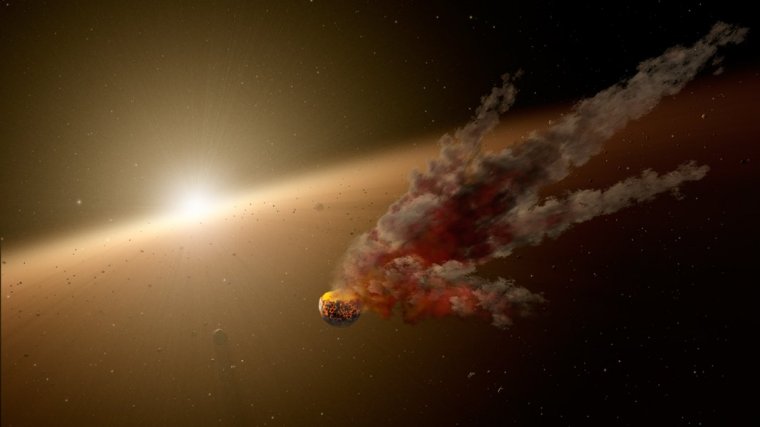| News / Space News |
Spitzer Telescope Witnesses Asteroid Smashup
NASA | SEPTEMBER 17, 2014
NASA's Spitzer Space Telescope has spotted an eruption of dust around a young star, possibly the result of a smashup between large asteroids. This type of collision can eventually lead to the formation of planets.

Building Planets Through Collisions (Artist's Concept). Image credit: NASA/JPL-Caltech
Scientists had been regularly tracking the star, called NGC 2547-ID8, when it surged with a huge amount of fresh dust between August 2012 and January 2013.
"We think two big asteroids crashed into each other, creating a huge cloud of grains the size of very fine sand, which are now smashing themselves into smithereens and slowly leaking away from the star," said lead author and graduate student Huan Meng of the University of Arizona, Tucson.
While dusty aftermaths of suspected asteroid collisions have been observed by Spitzer before, this is the first time scientists have collected data before and after a planetary system smashup. The viewing offers a glimpse into the violent process of making rocky planets like ours.
Rocky planets begin life as dusty material circling around young stars. The material clumps together to form asteroids that ram into each other. Although the asteroids often are destroyed, some grow over time and transform into proto-planets. After about 100 million years, the objects mature into full-grown, terrestrial planets. Our moon is thought to have formed from a giant impact between proto-Earth and a Mars-size object.
In the new study, Spitzer set its heat-seeking infrared eyes on the dusty star NGC 2547-ID8, which is about 35 million years old and lies 1,200 light-years away in the Vela constellation. Previous observations had already recorded variations in the amount of dust around the star, hinting at possible ongoing asteroid collisions.
In hope of witnessing an even larger impact, which is a key step in the birth of a terrestrial planet, the astronomers turned to Spitzer to observe the star regularly. Beginning in May 2012, the telescope began watching the star, sometimes daily.
A dramatic change in the star came during a time when Spitzer had to point away from NGC 2547-ID8 because our sun was in the way. When Spitzer started observing the star again five months later, the team was shocked by the data they received.
A very thick cloud of dusty debris now orbits the star in the zone where rocky planets form. As the scientists observe the star system, the infrared signal from this cloud varies based on what is visible from Earth. For example, when the elongated cloud is facing us, more of its surface area is exposed and the signal is greater.
When the head or the tail of the cloud is in view, less infrared light is observed. By studying the infrared oscillations, the team is gathering first-of-its-kind data on the detailed process and outcome of collisions that create rocky planets like Earth.
The team is continuing to keep an eye on the star with Spitzer. They will see how long the elevated dust levels persist, which will help them calculate how often such events happen around this and other stars. And they might see another smashup while Spitzer looks on.
YOU MAY ALSO LIKE


